Dungeness crab is a valuable species throughout the national marine sanctuaries of the West Coast from Washington state to throughout California. This communication toolkit is designed for educators and communicators to use to teach others about the impact of ocean acidification on Dungeness crab.
The toolkit includes: fact sheet; infographic; PowerPoint slideshow with script; reference list; resource list; public domain video B-roll; and public domain images.
This fact sheet is for a general audience and provides background information on how ocean acidification will affect Dungeness crabs, why Dungeness crabs are so important, and how NOAA is working to help protect this species.
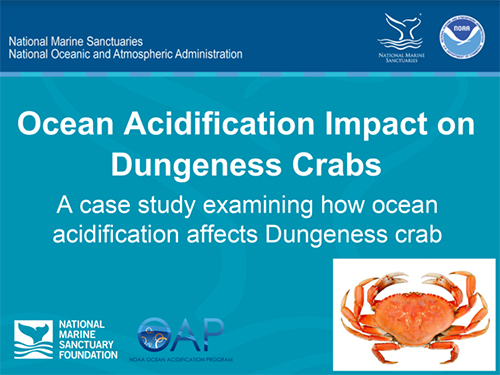
The PowerPoint provides a case study examining how ocean acidification affects Dungeness crab.
Presentation (PPTX)
Script (PDF)
This infographic poster shares the Dungeness crab and ocean acidification story visually and can be reproduced for education and outreach purposes.
Research suggests that Dungeness crabs are sensitive to the increasing acidity of our ocean. This NOAA Fisheries research will help answer the question of how ocean acidification affects Dungeness crab and will inform strategies to sustain this robust fishery.
References that go along with the fact sheet and PowerPoint slideshow can be found in this document. These references can guide you if you would like to dig deeper into current science behind ocean acidification impacts to Dungeness crab.
This document provides a list of websites and other resources related to Dungeness crab and ocean acidification.
B-roll footage sequence includes: Dungeness crab commonly inhabits the U.S. West Coast (0:20); Crabs eat mussels and other bivalves off the ocean floor (0:59); Dungeness crab is one of the most highly valued fisheries on the West Coast (1:30); Crab populations are surveyed to determine when to open and close season (2:05); Crabs are measured, sized, and checked for mating (2:52); Concern for ocean acidification effects on Dungeness crabs (3:30); NOAA scientists research ocean acidification effects on crab larvae (3:47); Larvae collected from traps in Puget Sounds (4:07); Crab larvae held in situ for ocean acidification experiments (4:53); CO2 levels monitored by MOATS (5:53); Crabs fed every three days (6:22); Crab development is tracked (6:42); Scientists document growth (6:59); Molting at different stages (7:09); Megalopa and juvenile stages, close up (7:37); end.
What is ocean acidification? And how could it affect the future of Dungeness crab, one of our favorite seafoods? Join us as we walk through a new national marine sanctuaries educational toolkit to equip you for teaching others about what ocean acidification could mean for the Dungeness crab, how this is currently being investigated, and resources to get more involved.
Download high-resolution public domain photos that can be used to communicate about ocean acidification research on Dungeness crab conducted by NOAA Northwest Fisheries Science Center. Click each photo to enlarge and then right click to "save as" to your computer. Please ensure that you use proper captions and photo credit with each photo.
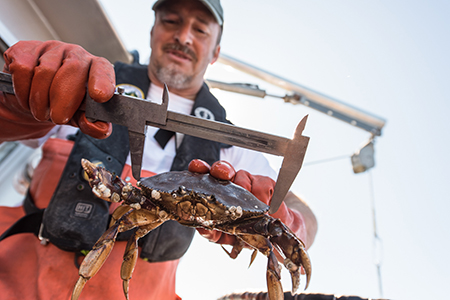
Washington Department of Fish and Wildlife checking the size and shell conditions of Dungeness crabs during a fall test fishery. (Credit: Austin Trigg/NOAA)
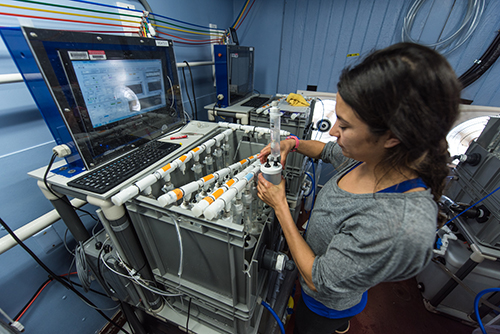
A NOAA scientist checks crabs being held on the MOATS CO2 treatment; each syringe is connected to an individual jar housing one crab. (Credit: Austin Trigg/NOAA)
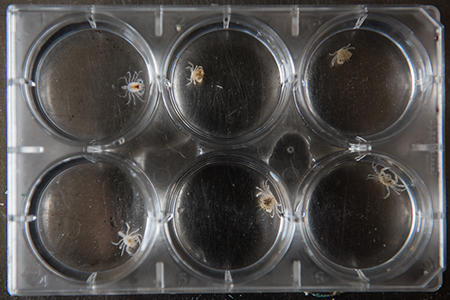
Dungeness megalopae (left-most top and bottom wells), Dungeness juvenile (bottom middle and right-most wells). (Credit: Austin Trigg/NOAA)
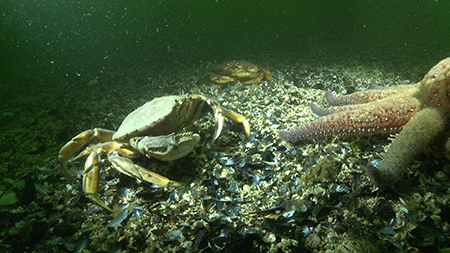
Dungeness crab facing off with a sea star underwater in its natural habitat. (Credit: Paul Hillman/NOAA)
This Ocean Acidification Communication Toolkit: Dungeness Crab Case Study was created and assembled by the National marine sanctuaries of the West Coast's education team and NOAA Northwest Fisheries Science Center with support from the National Marine Sanctuary Foundation and the NOAA Ocean Acidification Program.